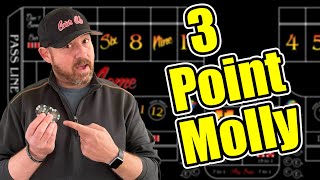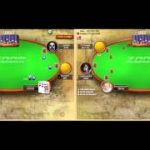Craps Strategy Video Information:
The best way to play craps according to the long term math is a pass or don’t pass bet followed with an additional odds bet. Today we look at the 3 point Molly, a famous strategy that utilizes this beneficial math, and tries to take advantage of a good roll by betting on three numbers while balancing risk.
You can download FREE POWER PRESS CHARTS here.
https://www.colorup.club/power
Get a free beginner craps video course here.
https://www.colorup.club/learntoplay
Also considering joining the Color Up Club here.
https://www.colorup.club
The opinions in this video are not guaranteed or warranty to produce any particular result. This video is for informational and entertainment purposes only. Any form of gambling carries an inherent risk. Never gamble with money you cannot afford to lose. Anyone who believes they, or someone they know, may have a gambling addiction, please seek help.
National Problem Gambling Helpline 1-800-522-4700 Call Text or Chat NCPGambling.org
Source: YouTube







Why is it called "Molly"?
Good video! Heading out next week. I’ve been thinking about my approach. My area usually only has $15 and $25 tables. I usually just place the 6 and 8 then cover more if I win. I like the quarter pounder idea, the 66 inside then 88, then regress. I like to get a feel for the table, the dealers, and the numbers being thrown. I know it’s random but I see so many numbers repeat so often. Hope I can find a long roll💥✌🏻
Great video! I like to think my comment on your '3 hit' video was inspiration when said I'd play two hit (rather than three, and not recover all my front line bet) and then off with the place bets until crap out. And if points hit use some proceeds to press pass line odds. A slow way to play, but reducing the vig %. And nice to have more time for the cocktail service….So given the Vegas Strip is all $25 min for most hours now, what is the vig difference between playing 'three point' on $10 table (with odds), versus just playing $25 with no odds?
I wonder if there is a strategy where you go “off” on your place bets for the first roll after a point is established, then back on if it’s not a 7. It seems like you are more likely to 7 out on the first roll, I’ve seen it so many times. Why not just wait 1 roll?
Do you like this or Heavy's Heatseeking more?
Jeremy, author N.B.Winkless Jr. reported this play as the “Simple Ponzer” in the early eighties. ( The Gambling Times Guide To Craps” ). No clue as to the “Molly” derivation…
Now, because it depends on winning more decisions than it loses, the tactic regards wins that occur during The Comeout to be immediate, and will have you racking those checks and thinking of them as a “bonus.”
This you need not do. Particularly if you should choose to think defensively. Or simply elect to restrict your initial, auxiliary action, to a single Come Bet, instead of the TWO additional Come bets already described.
It turns out, a Pass Line Bet plus only one (1) Come Bet is no more optimal than this Three Point Molly described ( see “The Craps Play Optimizer” by Gary Collopy ) but DOES restrain chips from being stampeded all over the layout unnecessarily.
You’ll NEED these funds, because a progressive schedule of increases is in your future, if the fates allow, permitting you to more fully take advantage of the dice as they are passing.
From this vantage, not only can you view * with jaundiced eye * ANY form of Same Bet – itis, to which you might otherwise fall prey. But you can do so, in three ways:
1.) As the dice “stay out” and consecutive passes begin to show, increase the flat portion of your Pass ( & Come ) bet (s) accordingly: $10, 15, 25, 35, 50, 75, 125, 175, 250, 350, 500, $750, etc.** ( correct units first described in “The Dice Doctor” by Sam Grafstein ©1981 ), unLESS:
2.) immediate winning “natural” Sevens and/or Elevens, should happen to show—before the point contest begins—in which case you’ll stack (“let ride,” or “bet back”) your newly acquired winnings ( momentarily termed “house money” ) atop your base bet! By which the resulting Three Hit- or Two Hit- flat Parlays ( if successful ) will pay you 7-to-1 ( $80 to the ten dollar flat ), or 3-to-1 ( $60 to the fifteen dollar flat ).
And
3.) by varying the dollar amounts of Pass & Come bet flats …WITH RESPECT to one another.m: Let us say, a $15 Pass Line flat, a $10 first Come Bet flat, and a $5 second Come Bet flat.
_____________________
Odds Bets, in all cases, are a variable of bankroll.
Just a suggestion.
Love the different strats.
I've seen a lay bet for the come roll a few times. I'm curious of your thoughts.
Setup for come out roll: Lay $30 each on 4,5,6,8,9,10, $4 horn and $XX on passline.
2,3,11,12 you win part of horn, loose passline, lay bets stay
4,5,6,8,9,10 rolled loose the horn, and loose lay bet for point. pull down rest of lay bets
7 rolled. win on lay 4,5,6,8,9,10(bet 180 = wins 118) and passline.
if multiple 7's are rolled on the come out roll. Your sitting good with little at risk.
support……………
See a horn, bet a horn
I dont understand the way you pay and place odds: The 5 and 9, for example, have true odds of 3:2 and that is what you seem to be paying out; however, the payout odds are 7:5; likewise the six and the eight are 6:5, respectifully for true odds with payouts at 7:6. Why the descreptancy? I saw you for instance pay out the single better $11 and the double better $22. could you please how you came to that calculaion. I think I know my error. Come bets pay true odds. The odds I cited previously are place odds. Correct?